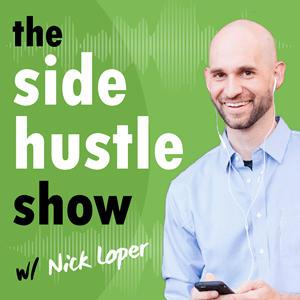 I can almost guarantee you’ve heard the phrase the “money is in the list.”
I can almost guarantee you’ve heard the phrase the “money is in the list.”
And all the experts, myself included, extol the virtues of building your email list, right? Because it’s the platform that you own and control.
But the question is, are you building an email list of buyers? Subscribers are great, but you’re not buying groceries on subscribers alone.
Pete Boyle is the founder of growthmodels.co and he has a unique list-building and business-building strategy that throws free lead magnets out the window in favor of low-priced products, starting at just $1, and has seen some exciting results, including $4,000 in just 10 days.
Tune in to Episode 664 of the Side Hustle Show to learn:
- how a $1 product can turn cold leads into paying customers (without ads)
- why low-ticket offers convert better than free lead magnets
- how to stack simple offers into a $250+ funnel that leads to high-ticket sales
(Start your own $1 product experiment at growthmodels.co/dollar.)
Sponsors
- Airbnb — Discover how much your home could be worth and find a professional co-host today!

- Mint Mobile — Cut your wireless bill to $15 a month!
- Indeed – Start hiring NOW with a $75 sponsored job credit to upgrade your job post!
- OpenPhone — Get 20% off of your first 6 months!
- Shopify — Sign up for a $1 per month trial!
Round 1: The $1 Product Challenge
When Pete launched this, he didn’t have some giant audience of buyers ready to go. But he needed revenue fast, so tested a low-ticket product that people could actually use right away.
Over one weekend, he created 4 custom GPTs to help with content marketing. These were functional tools that walked users through things like choosing a topic, writing a solid headline, briefing a writer, and even drafting the post.

That $1 offer brought in $4,000 in 10 days without running ads. And because the offer was genuinely useful, the people who bought were way more likely to buy again.
What If You Don’t Have an Audience?
Pete didn’t either… at least not for this offer. His email list wasn’t the right fit, so he started showing up in free content marketing communities. He calls it “spearfishing.”
No pitching. Just helpful posts, real insights, and a soft mention of what he’d built. If someone liked or commented, he followed up with a quick, friendly DM.
“Hey, how’s it going? You enjoyed the post; thanks so much for engaging.”
And when they buy the product, he would send them a simple thank-you page with links to access the GPTs.
From $1 to $250: How the Offer Stack Works
That $1 product was just the entry point. Once someone bought, Pete used a simple checkout stack to increase the value of each sale without making it complicated for the buyer.

Bump offer ($47):
A checkbox on the checkout page that says, “Want to learn how to build your own GPTs?”
Buyers got tutorial videos + a reusable prompt template.
1-click upsell ($97–$197):
After someone grabbed the initial GPTs (and maybe the bump), they landed on a follow-up page with another offer: a deeper dive into content optimization and promotion.
Because once someone has the content… now what? That’s the next problem.
So, from one $1 offer, Pete was able to bring in customers who might spend $47, $97, even $250. And because it was all digital and pre-recorded, there was no extra time required to fulfill any of it.
Why a $1 Product Outperforms Freebies
Free lead magnets attract freebie seekers. They might join your list, grab your ebook or checklist, and never open another email again. That’s just how it goes because they’re collecting “nice-to-haves,” not looking for actual solutions.
But when someone pays you, even just a dollar, the relationship shifts.
They’ve made a decision. They’re looking for help. They want to solve a real problem.
Pete put it best: “people who pay, pay attention.”
And according to the numbers, someone who pays even a dollar is up to 12x more likely to buy again compared to someone who only opts in for free content.
Selling Information Isn’t Enough Anymore
Most people don’t need more information. They’re drowning in it.
What they’re actually looking for is something they can use. Not a 70-page ebook they’ll never read. Not a six-part video series they’ll forget to finish. They want something they can plug into their business and see a result.
Pete’s GPT tools were functional. You answer a few questions, and then you’ve got a draft, a headline, a content brief.
That’s the shift: from “let me teach you how” to “here’s the thing that does it.”
He used the example of “five exercises you can do in 15 minutes from your sofa.” It’s helpful AND accessible. It fits into someone’s life immediately. And when your $1 product delivers that kind of instant utility, it builds trust fast.
Can This Scale? Ads, AOV, and What to Know First
So you’ve got a $1 offer that’s converting. People are buying, taking action, maybe even moving up your funnel. The next question is: Can this scale?
Yes… but only if your numbers make sense.
Before ads, Pete validated everything manually first: spearfishing in communities, having real conversations, and making sure people were actually buying before spending a dime on paid traffic.
Once the funnel was working, then he layered in ads. But your average order value (AOV) has to beat your customer acquisition cost (CAC). Otherwise, you’re just lighting money on fire.
Pete’s CAC in the business/marketing space is around $35–$40 per customer. In less crowded niches — like language learning or niche coaching — CAC can drop as low as $5.
Tools/Tech
One of the best parts of Pete’s approach is how low-tech it actually is. You don’t need fancy software or a big team to make this work. Here’s what he used:
- ThriveCart – for the $1 checkout, bump offer, and 1-click upsell
- Stripe or PayPal – easy payment processing (ThriveCart integrates with both)
- Loom – to record simple tutorial videos
- ConvertKit – for automated follow-up emails
- Descript – for editing YouTube videos fast by editing the transcript
- SocialBee – to schedule and repurpose video clips across multiple platforms
Round 2: Donate a Business Idea
Pete wanted a directory of affiliate marketers with engaged email lists.
There are already tools out there for newsletter swaps, like Lettergrowth and the built-in options in Beehiiv and ConvertKit’s Creator Network, where you can recommend each other’s newsletters. And platforms like SparkLoop let you pay for new subscribers via referrals.
But most of those are geared toward list growth, not sales.
Pete’s idea takes it further: what if you could search and connect with affiliate marketers who have proven audiences, and are open to promoting aligned offers? Not just one-off newsletter mentions, but full email sequences. Not “sponsors,” but real affiliate partners.
This would save so much time on outreach and help both sides. Creators could monetize more effectively, and offer owners could find the right-fit partners faster.
Matt McWilliams from Episode 549, aka “The Affiliate Guy” is someone who already has deep experience coordinating these kinds of launches behind the scenes.
And if you want to geek out more on the mechanics of building a directory-style business like this, check out Episode 647 with John Rush.
Round 3: Triple Threat
Marketing Tactic
Pete’s also doubling down on YouTube. Not for the ad revenue, but for the visibility. It’s a platform where you can grow organically and run paid campaigns on the same content, which is a rare combo.
He’s currently testing daily long-form videos (around 10 minutes each), using them to attract the right audience, and then retargeting viewers with conversion-focused ads, pointing them to low-ticket offers like the $1 Product Challenge.
Favorite Tool
Editing video is a time suck. Descript makes it easy. Just edit the transcript and the video updates. Plus, it can auto-generate clips from long-form content (perfect for Shorts, TikToks, Reels).
Then there’s SocialBee, which helps him queue up and distribute all that content across platforms without manually scheduling every post.
Favorite Book Right Now
Great Leads is a copywriting classic that breaks down how to start any sales message.
It’s all about hooking attention fast, which is exactly what you need when you’re creating scroll-stopping content or trying to turn a cold viewer into a paying customer.
Episode Links
- Growthmodels.co
- Growthmodels.co/dollar
- 16 Marketing Tips from Side Hustle Show Listeners
- The 8 Fastest Ways to Build Your Email List in 2023
- How to Start an Online Directory as a Side Hustle
- ThriveCart
- Stripe
- PayPal
- Loom
- ConvertKit
- Descript
- SocialBee
- Lettergrowth
- Beehiiv
- ConvertKit’s Creator Network
- SparkLoop
- Great Leads
Looking for More Side Hustle Help?
- Start Your Free $500 Challenge. My free 5-day email course shows you how to add $500 to your bottom line.
- Join the free Side Hustle Nation Community. The free Facebook group is the best place to connect with other side hustlers and get your questions answered.
- Download The Side Hustle Show. My free podcast shares how to make extra money with actionable weekly episodes.








No responses yet